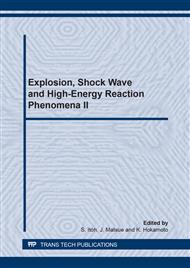p.303
p.309
p.315
p.321
p.327
p.333
p.339
p.345
p.351
Investigation of Jet Formation with Overdriven Detonation in High Density Explosive
Abstract:
To increase largely the performance of shaped charge, it is required to generate detonation velocity much higher than CJ velocity or detonation pressure much higher than CJ pressure of existing high explosives. One solution is the application of overdriven detonation phenomena. In this study, the effects of overdriven detonation in tungsten loaded high density explosive on the performance of shaped charge were demonstrated by experiments and numerical simulation. Sample shaped charge was composed of the inner layer tungsten loaded high density PBX and outer layer high velocity PBX. Concentration of tungsten powder in high density PBX was varied from 20 to 60% in mass. The pressure of overdriven detonation in inner layer PBX was measured by PMMA gauge, and was shown to be higher than 50GPa. The experimental results showed that the initial jet velocity and jet penetration velocity in target plates were largely increased by the effects of the overdriven detonation in tungsten loaded high density PBX.
Info:
Periodical:
Pages:
327-332
Citation:
Online since:
November 2007
Authors:
Price:
Сopyright:
© 2008 Trans Tech Publications Ltd. All Rights Reserved
Share:
Citation:


